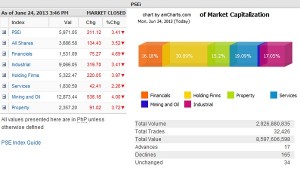Stock market nears ‘bear’ territory
Prospects of rising US interest rates and a slowing Chinese economy on Monday dragged the local stock market barometer below the 6,000 mark, bringing the local bourse on the brink of returning to a “bear” market.
The main-share Philippine Stock Exchange index (PSEi) slumped 211.12 points or 3.41 percent to close at 5,971.05. The index has pulled back by about 19 percent since hitting the peak of the recent bull run at 7,400 in mid-May.
A market is technically deemed having reversed from a “bull” to a “bear” market when it has retreated by 20 percent from the peak.
As global funds continued to exit emerging markets, the peso also closed weaker against the dollar Monday. The greenback continued to gain strength following signals that the American economic recovery is gaining traction, prompting the US Federal Reserve to signal that it would soon end its aggressive bond-buyback activities.
At the local stock market, all counters were in the red, led by the financial (-4.69 percent) and mining/oil (-4 percent) counters.
With the PSEi breaking down the 6,000 support, this puts the 5,500-5,800 levels at risk, according to Banco de Oro Unibank chief strategist Jonathan Ravelas.
“We’re just correcting excesses that we saw,” said Jose Vistan, head of research at AB Capital Securities.
Vistan said he believed the PSEi would be able to establish a base at around 5,600 to 5,700 at which local valuations would go down in line with comparable markets in the region at around 15x price to earnings (P/E). When the index hit a peak of 7,400, this represented a P/E ratio of about 22x, which meant that the market paid 22 times the amount of money they expected to make in this market.
“If you look at underlying fundamentals and we remove (excess liquidity from) QE (quantitative easing of the US Fed), we’re not fundamentally bearish. We may turn bearish technically, but we’re far from bearish fundamentally,” Vistan said. “This is just a consequence of having overdone it. The run-up to 7,400 was overdone as we moved ahead of fundamentals.”
The PSE said the recent selldown was a result of an “overreaction” to global developments. “There is a disconnect between good local economic fundamentals and the short-term market psychology. The explanation that investors were reallocating back to developed markets is not exactly accurate, with real movements going from the equities market into cash in a period of high volatility,” PSE president Hans Sicat said.
“Looking at the bigger picture, the recent index setback is not equivalent to degrading the strong fundamentals. We believe our listed companies will remain resilient and will continue to find ways to take advantage of the favorable local macroeconomic environment,” he added.
The PSE reported Monday that cumulative earnings of listed firms surged 23.3 percent year-on-year in the first quarter to P163.42 billion on the back of an average revenue growth of 15.4 percent to P1.21 trillion.
“The phenomenal income performance of listed companies has been the main driver of the stock market’s growth this year while also providing a firm basis for investor optimism on the prospects for listed companies moving forward. More importantly, we believe that expansion of this magnitude should have contributed in a big way to the impressive growth rate of the economy so far this year,” Sicat said.
Value turnover amounted to P8.56 billion. There were 165 decliners that overwhelmed 17 advancers while 34 stocks were unchanged.
The day’s biggest index decliner was MWC (-11 percent). The company’s bid to enter the Indonesian market is at risk due to signals from the leaders of Jakarta to instead nationalize the capital’s water concessions.
Other big index decliners for the day were Bloomberry and MPI, which fell more than 8 percent while Belle lost 7 percent. Megaworld, Metrobank and Philex all slid by 6 percent while AGI, Jollibee, Belle and AC faltered by more than 5 percent.
Meanwhile, the local currency looked ready for another week of losses after it retested the 44-to-a-dollar level Monday. The peso lost 2.13 percent last week.
The currency traded as low as 43.95 to $1 before closing at 43.84 Monday, lower than the 43.72:$1 close last Friday. The peso opened the day at 43.85 and was at its strongest at 43.61 to $1. Trading volume was flat at $1.08 billion, just slightly ahead of last Friday’s level.


